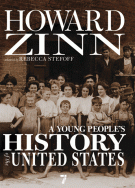Using Annotation in History: A Year of Lessons Learned
A MiddleWeb Blog
 by Aaron Brock & Jody Passanisi
by Aaron Brock & Jody Passanisi
We both teach history in the Los Angeles metro area – Aaron in Compton USD, a large public system, and Jody in an independent day school. We often plan together. Although our methods may sometimes differ, we have the same goal for our eighth graders: We want our students to read, comprehend, and analyze text.
So the question is: how to make them responsible for the material? We aren’t going to have them answer the questions at the back of the book. (Are there questions in the back of our history books anymore?). So it begs the question: what do we do so that
(1) the students will read; and
(2) the students will understand and be responsible for what they read?
Our shared answer: We taught our students how to annotate as they read and study history.
How we went about it
Taken together, 0ur approaches to annotation instruction might spark some ideas among teachers in a range of settings. Here’s how each of us went about it.
Aaron:
Before I introduced annotation to my students, I used the previous year’s English data and written samples collected during the first week of school to divide students into three tiers. Students were given slightly different instructions based on the amount of support they would need to comprehend, summarize and analyze texts in class.
 The tiers were fluid; as students demonstrated mastery of the skills associated with annotating historical texts, they were moved to higher tiers. Conversely, students that struggled were moved to a tier more in line with their skill level. Tier 1 and Tier 2 instructions were more focused on vocabulary and reading comprehension strategies, whereas the Tier 3 instructions were geared more toward analysis and evaluation.
The tiers were fluid; as students demonstrated mastery of the skills associated with annotating historical texts, they were moved to higher tiers. Conversely, students that struggled were moved to a tier more in line with their skill level. Tier 1 and Tier 2 instructions were more focused on vocabulary and reading comprehension strategies, whereas the Tier 3 instructions were geared more toward analysis and evaluation.
Although Tier 3 students were asked to do more sophisticated analyses of the assigned texts, their total workload was less than that of the other two groups. This not only provided additional scaffolding for the students who needed it, it also encouraged students with stronger skill sets to push themselves (too often, more advanced students feel they are punished for displaying their talent with additional work).
The core of the annotation instructions were the same for all skill levels:
- Read the text aloud in a small team without making any notes
- Go back through to text to locate recurring themes and concepts
- Create a label or title for each of these repeated ideas
- Underline the sentences in which the repeated ideas occur
- Write the labels or titles for the repeated ideas in the margins next to the underlined sentences
 When students begin annotating on their own, many fall into the habit of underlining the names of historical characters or places. I attempt to head this off when modeling the activity for the class, drawing a clear distinction between repeated ideas, and words that simply come up a lot.
When students begin annotating on their own, many fall into the habit of underlining the names of historical characters or places. I attempt to head this off when modeling the activity for the class, drawing a clear distinction between repeated ideas, and words that simply come up a lot.
For my seriously struggling readers, I do allow them to start with repeated words and names. If I have time, I ask these students probing questions about the possible themes that their underlined words suggest.
All students are required to use their annotation to create a set of notes. Because my students are familiar with Cornell Notes, I ask for notes in that particular format. The students use the labels that they wrote in the margins of the text as their key points or main ideas, and the underlined sentences are summarized in the primary note-taking section.
When students rearrange the text in this way, they are creating their own categories and locating patterns that may not otherwise have been clear. My students with very limited literacy skills copy out sentences that match main ideas they develop with classmates, and this provides a fresh angle from which to view the text. When these same students re-read a text that they have annotated and taken notes about, they will usually find they understand more than from their first two passes.
Jody:
I began the year having my students use QAR, which Shara Peters and I wrote about previously, as the primary way to ensure engagement with the text. However, after discussions with my English department and with Aaron, I realized it would be beneficial to start doing annotations as well.
In January, I adapted Aaron’s annotation instructions and tried it out on the kids. While Aaron had three scaffolded levels of annotations, because I was starting out halfway through, I tried to adapt just Aaron’s third level of annotations for my class.
 To introduce, I modeled the process with the students multiple times and then had them do independent practice. The text we used first was Zinn’s “Columbus and the Indians” from A Young People’s History of the United States. Because my primary reason for looking at Zinn at that time was to teach about bias, I tried to integrate these two objectives (probably wouldn’t do it that way next time!).
To introduce, I modeled the process with the students multiple times and then had them do independent practice. The text we used first was Zinn’s “Columbus and the Indians” from A Young People’s History of the United States. Because my primary reason for looking at Zinn at that time was to teach about bias, I tried to integrate these two objectives (probably wouldn’t do it that way next time!).
I also created a flipped classroom video and a set of instructions for the students to access on our learning management system, so that the students would have the benefit of reviewing the process and instructions at home if they needed.
I started out with the usual Cornell Notes model with repeated ideas on the right hand side and main ideas on the left. But because my students were primarily accessing and marking up these texts electronically, over time I began to be a lot more lax in requiring the Cornell notes. Many of my students ended up annotating, writing their main ideas, and underlining repeated ideas in different colors, right on the page of digital text.
What did and didn’t work
Aaron:
This is the first year that I have used annotation in my classroom, and from the start I recognized that there were a great many aspects of the process I would need to revise.
 One of the first challenges I had to address was the student tendency to annotate only the first few paragraphs of a text. If they could locate repeated words or ideas early in the text, many students would technically complete the assignment without actually using it as a tool to comprehend or analyze the text.
One of the first challenges I had to address was the student tendency to annotate only the first few paragraphs of a text. If they could locate repeated words or ideas early in the text, many students would technically complete the assignment without actually using it as a tool to comprehend or analyze the text.
I managed to create a solution for this particular habit on the fly; I told students that each main idea must be located in at least three different paragraphs, and that all three ideas could not come from the same three paragraphs.
Another problem I encountered was too much highlighting or underlining. Some students underlined more than seventy percent of the texts they were given. This usually went along with a failure to write anything in the margins, so it was more a failure of oversight and modeling than a problem with the assignment itself.
When asked to explain why they had underlined or highlighted any particular sentence, these overzealous page painters always shrugged. Next year I plan to include a rule that NOTHING can be marked without an explanation in the margin, and to be draconian in my enforcement of said rule for the first few texts.
Jody:
Can I just say “same here”? Honestly, many of my issues were similar. The biggest problem – that Aaron remedied and I have not yet resolved – is that some students were just reading the first few paragraphs of text. I will definitely be implementing his solution where the main ideas have to be found in at least three different paragraphs.
I also found that since my students were reading digitally, they eschewed the Cornell Notes model and just wrote the main ideas in text boxes on the digital text itself. I think in the future I will press them to use the Cornell Notes model. It requires a full engagement with the text, and extra steps (students LOVE extra steps!) that will ensure they are actually taking the ideas from the text, processing and organizing them, and simplifying the details into a main idea. I think that the digital shortcut was a hindrance in this case.
 Additionally, I need to do a better job explaining the rules of what a main idea is and what it is not. For example, students often would say “Thomas Jefferson” was a main idea. I would always counter: “that is a topic, not a main idea.” But this is semantics for them.
Additionally, I need to do a better job explaining the rules of what a main idea is and what it is not. For example, students often would say “Thomas Jefferson” was a main idea. I would always counter: “that is a topic, not a main idea.” But this is semantics for them.
I need to explicitly teach “main idea” to the students when I introduce annotations (this time at the beginning of the year and not halfway through!). Aaron’s suggestion: Use Scrabble rules: no proper nouns. I would always say that to make it a main idea, they needed a verb with their topic.
What we plan to do next
Aaron:
While I am glad that I began playing with annotation this year, it definitely felt like an experiment. It was not as well integrated into my curriculum as I would have liked, and I never built on the initial assignment to encourage progressively deeper reading of our texts. Those are issues I will work on in the future.
Jody:
Agreed. For all of the challenges that I describe above, I am glad that I implemented a more disciplined way of attacking text. My students reflected about this at the end of the year, and while they didn’t always enjoy it, they said that it helped them to understand how to read text better.
I plan to introduce annotations at the beginning of the year, instead of halfway through, and I am thinking about also implementing the three tiered plan, as Aaron does. I think it will help with differentiation and will allow students to reflect upon and measure their own progress with reading challenging text – increasing motivation and giving them something to work toward.
Either way, we are both happy that our students are reading more historical texts from primary and secondary sources. How do you engage your students when they read historical texts? and how do you help them to comprehend the texts?
To learn more about what happened next,
see Aaron Brock’s October 2014 post,
Teaching History Students to Annotate: Reviving the 5 W’s.
Aaron Brock has been a middle school social studies teacher in the Compton Unified School District for five years. He has a BA in History from California State University Northridge and received his teaching credential through UCLA’s TeachLA program. His love of history dates back to his own adolescence, and it is his goal to help students discover the aspects of history about which they can get excited. Follow Aaron on Twitter @HistoryBrock.
Jody Passanisi is an eighth grade U.S. History teacher at an independent school in the Los Angeles area. She earned her teaching credential and an M.S. in education from Mount St. Mary’s College and an M.A. in religious studies from the Graduate Theological Union. Follow her on Twitter @21centuryteachr.

































